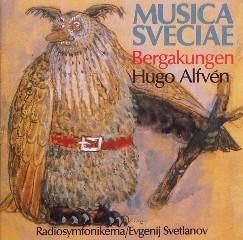Hugo Alfvén - Bergakungen (The Mountain King, ballet) [1991]
Hugo Alfvén - Bergakungen (The Mountain King, ballet) [1991]

Bergakungen, ballet-pantomime, Op. 37, R99 Akt I 1 En Grönskande Sommaräng 4:49 2 Intåget 1:32 3 Första Dansen 1:51 4 Andra Dansen 2:11 5 Tredje Dansen 6:39 6 Sjöjungfrur Och Troll. 1:a Dansen 1:44 7 Sjöjungfrur Och Troll. 2:a Dansen 2:50 8 Småtrollens Dans 1:16 9 Sjöjungfrur Och Troll. 1:a Dansen (Repris) 2:44 10 Vallflickan Blåser I Lur 4:30 11 Dans 1:22 12 Vallflickan Och Humpe 1:29 13 "Sommarregn" 2:41 Akt II 14 I Skogen 2:05 15 Porten Öppnas 2:40 16 Vallpojken Och Humpe 3:47 17 "Besvärjelse" 2:42 Akt III 18 Bergakungens Sal 1:12 19 Flickans Första Dans. Trollens Jubel 3:13 20 Flickans Andra Dans 2:17 21 "Vallflickans Dans" 1:13 22 "Trollflickans Dans" 5:01 23 Trollens Första Dans 4:15 24 Trollens Andra Dans. Berget Rämnar 4:04 25 Befrielsen. Vallflickans Och Vallpojkens Dans 6:16 26 Snöstormen 2:04 27 Gryning 2:10 Radiosymfonikerna Evgenij Svetlanov - conductor
Alfvén was primarily known as a choral composer in his native country of Sweden, although his orchestral rhapsody Midsummer Vigil was well known and had carried his fame around the world. He worked for years on this full-length ballet score (1916-1923) based on the folk tales of the king of the mountain trolls (essentially the same figure also musically portrayed by Edvard Grieg In the Hall of the Mountain King). Alfvén's score is exceptionally colorful and beautifully orchestrated, with a rich, romantic sound.
It was a major success when premiered in the 1920s, but by the 1930s it has lost its novelty and it gradually disappeared from the stage. (Alfvén's music was suffering the fate of not sounding ugly enough to qualify as "modern" music and had not established itself sufficiently in the ballet repertory which, internationally, is very limited and conventional.)
Disappointed by this, Alfvén recycled portions of the music in his Fifth Symphony and also devised a four-movement suite. By the time of the composer's death in 1960, this was already becoming internationally established and soon became the best-known Alfvén piece after "Midsummer Rhapsody." The first movement, "Besvärjelse (Invocation)" depicts a bright summer night in terms of the magical mood of a "white night." "Trollflickans dance" (Troll Maiden's Dance) is a rather grotesque and lively number. "Sommaregn" (Summer Rain) is another lyrical depiction of nature, and the concluding "Vallflickans dans" (Herd-Maid's Dance), a vigorous virtuoso dance, has become the best-known excerpt from the score. ---Joseph Stevenson, allmusic.com
download (mp3 @320 kbs):
yandex mediafire ulozto gett bayfiles








